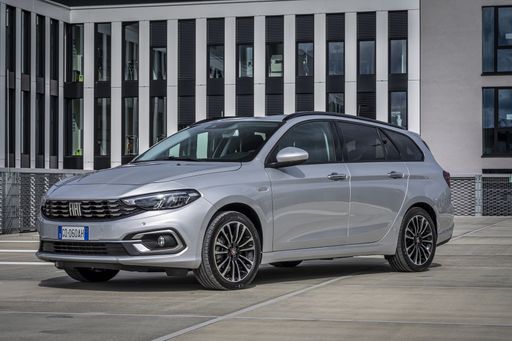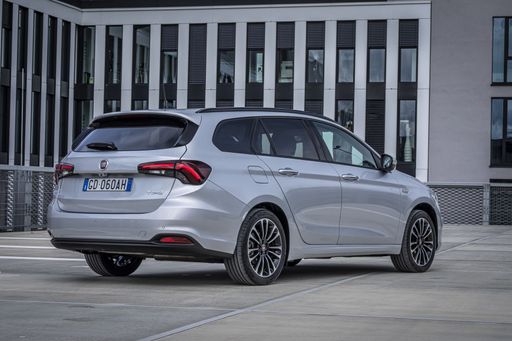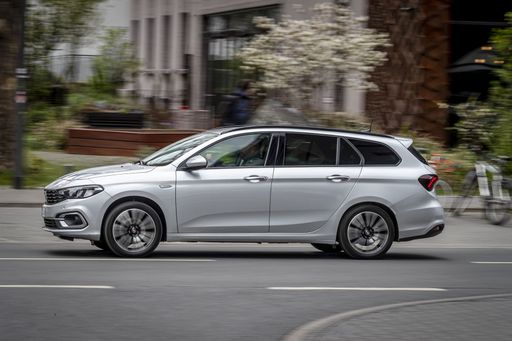Ferrari Purosangue VS Fiat Tipo Wagon – Specs, Efficiency & Price Comparison
Which model is the better choice – the Ferrari Purosangue or the Fiat Tipo Wagon? We compare performance (830 HP vs 130 HP), boot capacity (473 L vs 550 L), efficiency (17.10 L vs 4.70 L), and of course, the price (324700 £ vs 21000 £).
Find out now which car fits your needs better!
The Ferrari Purosangue (SUV) is powered by a Petrol engine and comes with a Automatic transmission. In comparison, the Fiat Tipo Wagon (Estate) features a Petrol MHEV or Diesel engine and a Automatic or Manuel gearbox.
When it comes to boot capacity, the Ferrari Purosangue offers 473 L, while the Fiat Tipo Wagon provides 550 L – depending on what matters most to you. If you’re looking for more power, you’ll need to decide whether the 830 HP of the Ferrari Purosangue or the 130 HP of the Fiat Tipo Wagon suits your needs better.
There are also differences in efficiency: 17.10 L vs 4.70 L. In terms of price, the Ferrari Purosangue starts at 324700 £, while the Fiat Tipo Wagon is available from 21000 £.
Compare all the key specs now and find out which model fits your lifestyle best!
Ferrari Purosangue
The Ferrari Purosangue marks the brand's first venture into the SUV segment, combining the luxury and performance synonymous with the Italian manufacturer. Its sleek design and powerful engine deliver a driving experience that is both exhilarating and refined. Inside, the Purosangue offers a sumptuous interior that perfectly balances sportiness with comfort, ensuring it stands out in the competitive luxury SUV market.
detailsFiat Tipo Wagon
The Fiat Tipo Station Wagon offers a spacious and practical solution for families seeking value without sacrificing comfort. Its sleek design and modern interior features create a pleasant driving experience, complemented by a range of user-friendly technology. On the road, the Tipo Estate provides a smooth drive, making it an ideal companion for both urban and longer journeys.
details @ media.stellantis.com
@ media.stellantis.com
 @ media.stellantis.com
@ media.stellantis.com
 @ media.stellantis.com
@ media.stellantis.com

|
|
|
|
|
Costs and Consumption |
|
|---|---|
|
Price
324700 £
|
Price
21000 - 27000 £
|
|
Consumption L/100km
17.10 L
|
Consumption L/100km
4.7 - 5.4 L
|
|
Consumption kWh/100km
-
|
Consumption kWh/100km
-
|
|
Electric Range
-
|
Electric Range
-
|
|
Battery Capacity
-
|
Battery Capacity
-
|
|
co2
389 g/km
|
co2
122 - 125 g/km
|
|
Fuel tank capacity
100 L
|
Fuel tank capacity
50 L
|
Dimensions and Body |
|
|---|---|
|
Body Type
SUV
|
Body Type
Estate
|
|
Seats
4
|
Seats
5
|
|
Doors
5
|
Doors
5
|
|
Curb weight
2033 kg
|
Curb weight
1455 - 1470 kg
|
|
Trunk capacity
473 L
|
Trunk capacity
550 L
|
|
Length
4973 mm
|
Length
4571 mm
|
|
Width
2028 mm
|
Width
1792 mm
|
|
Height
1589 mm
|
Height
1514 mm
|
|
Payload
-
|
Payload
475 kg
|
Engine and Performance |
|
|---|---|
|
Engine Type
Petrol
|
Engine Type
Petrol MHEV, Diesel
|
|
Transmission
Automatic
|
Transmission
Automatic, Manuel
|
|
Transmission Detail
Automat. Schaltgetriebe (Doppelkupplung)
|
Transmission Detail
Dual-Clutch Automatic, Manual Gearbox
|
|
Drive Type
All-Wheel Drive
|
Drive Type
Front-Wheel Drive
|
|
Power HP
830 HP
|
Power HP
130 HP
|
|
Acceleration 0-100km/h
3.30 s
|
Acceleration 0-100km/h
9.1 - 10.1 s
|
|
Max Speed
312 km/h
|
Max Speed
206 - 207 km/h
|
|
Torque
692 Nm
|
Torque
240 - 320 Nm
|
|
Number of Cylinders
12
|
Number of Cylinders
4
|
|
Power kW
533 kW
|
Power kW
96 kW
|
|
Engine capacity
6496 cm3
|
Engine capacity
1469 - 1598 cm3
|
General |
|
|---|---|
|
Model Year
2023
|
Model Year
2024
|
|
CO2 Efficiency Class
G
|
CO2 Efficiency Class
D
|
|
Brand
Ferrari
|
Brand
Fiat
|
Ferrari Purosangue
Introduction to the Ferrari Purosangue
In an ambitious blend of performance, luxury, and innovation, the Ferrari Purosangue marks Ferrari's first venture into the SUV segment. This groundbreaking vehicle merges the legendary Ferrari essence with the versatility and comfort of an SUV, delivering a driving experience like no other.
Design and Elegance
The Ferrari Purosangue is a visual masterpiece with dimensions that complement its formidable performance capabilities. Its sleek 4973 mm length, 2028 mm width, and 1589 mm height establish an imposing presence on the road. This elegantly crafted SUV combines aerodynamic efficiency with Ferrari's signature aesthetic, ensuring it turns heads wherever it goes.
Powertrain and Performance
At the heart of the Purosangue lies a commanding 6.5-litre V12 engine, producing an intense 830 PS (533 kW) and 692 Nm of torque. This powerhouse propels the Purosangue from 0 to 100 km/h in a mere 3.3 seconds and reaches a top speed of 312 km/h, exemplifying the raw power and throttle response expected from Ferrari. Paired with an automatic transmission featuring a dual-clutch system, the Purosangue shifts with precision, providing seamless acceleration and optimal performance.
Advanced All-Wheel Drive System
The Purosangue's sophisticated all-wheel-drive system ensures impeccable traction across varying terrains, combining control and stability to enhance the driving experience. This capability brings a new level of versatility, enabling drivers to venture beyond traditional sports car limits without sacrificing the thrill of a Ferrari.
Innovative Features and Technology
Inside, the Ferrari Purosangue is equipped with cutting-edge technology designed to provide both comfort and functionality. The interior is a blend of advanced digital interfaces and classic Ferrari craftsmanship, offering four luxurious seats and state-of-the-art infotainment options. The driving dynamics can be customised via the advanced driving mode settings, ensuring adaptability to driver preferences and road conditions.
Environmental Considerations
Despite its remarkable performance, the Purosangue also pays attention to environmental factors. With a fuel consumption of 17.1 L/100km and CO2 emissions at 389 g/km, the Purosangue seeks a balance between power and environmental responsibility. However, it holds a CO2 efficiency class of G, indicating the challenge of achieving lower emissions within the high-performance SUV market.
Conclusion
The Ferrari Purosangue redefines the luxury SUV market, presenting an unmatched blend of performance, style, and versatility. Through innovative engineering and Ferrari's iconic design language, it offers a driving experience that remains true to the brand's illustrious heritage. For those seeking a unique combination of SUV practicality and Ferrari performance, the Purosangue sets a new benchmark in automotive excellence.
Fiat Tipo Wagon
Introduction to the Fiat Tipo Station Wagon
The Fiat Tipo Station Wagon has long been a staple in the automotive world, celebrated for its practical design, spacious interior, and affordability. The 2024 model continues this tradition, offering impressive updates in technology and performance, making it a significant contender in the compact estate car market. Here, we take a closer look at what makes the Fiat Tipo Kombi a standout choice.
Engine and Performance
Under the bonnet, the Fiat Tipo Station Wagon showcases its versatility with a choice of powertrains. Its offerings include a 1.5 GSE Hybrid with a mild-hybrid system that enhances fuel efficiency and provides a responsive driving experience. This engine choice delivers 130 PS and achieves a commendable fuel consumption rate of 5.4 L/100km.
For diesel enthusiasts, the 1.6 MultiJet engine provides a robust performance with the same 130 PS but boasts an even lower fuel consumption of 4.7 L/100km. Both engine variants offer a front-wheel drive system which is complemented by either a dual-clutch automatic transmission or a traditional manual gearbox, ensuring a pleasurable driving experience tailored to individual preferences.
Advanced Technology and Innovations
The 2024 Fiat Tipo Station Wagon is equipped with a suite of modern technologies, enhancing both safety and convenience. The model features an advanced infotainment system that integrates seamlessly with smartphones, offering navigation, media, and communication tools via a sleek and intuitive touchscreen interface.
On the safety front, the Tipo Station Wagon is equipped with various driver assistance systems, including adaptive cruise control and lane-keeping assist, ensuring both comfort and security on the road. These innovations reflect Fiat's commitment to merging safety with cutting-edge technology.
Design and Comfort
From a design perspective, the Fiat Tipo Station Wagon maintains a sleek and modern aesthetic, characterised by clean lines and a distinctive front grille that conveys confidence. The vehicle's dimensions (4571 mm in length, 1792 mm in width, and 1514 mm in height) provide ample space for passengers and gear, while a generous boot offers 550 litres of cargo capacity.
Inside, the Tipo Station Wagon is designed with comfort in mind, accommodating five passengers comfortably. The interior cabin is spacious, with quality materials and ergonomic seating ensuring that long journeys are undertaken in comfort.
Efficiency and Environmental Considerations
Efficiency is at the core of the Fiat Tipo Station Wagons design, as evidenced by its low fuel consumption figures and CO2 emissions ranging between 122 and 125 g/km, securing a CO2 efficiency class of D. This makes the vehicle an environmentally conscious choice without sacrificing performance or convenience.
Conclusion
For those in search of a reliable, spacious, and technologically advanced vehicle, the Fiat Tipo Station Wagon stands out as an excellent option. Its combination of performance, efficiency, and modern technology, all wrapped in a stylish design, ensures that it remains a top choice for 2024 and beyond.
The prices and data displayed are estimates based on German list prices and may vary by country. This information is not legally binding.
